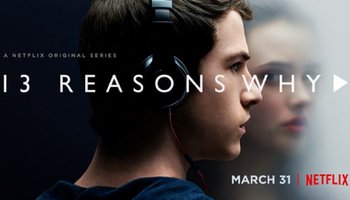We had a great on-air conversation about Thirteen Reasons Why on Kansas City Public Radio as the film and controversy continue to draw considerable attention. While I remain convinced that this is an important, if imperfect, tool for discussing a broad array of teen issues, I’ve heard some very intelligent dissent. Very little of it has come from media sources or psychiatrists with more expensive publicity machines that I have. It has come from teens and young adults, some of whom watched the film and loved it. Others watched it and hated. Some couldn’t get through it, mostly because it’s pretty long and at times tedious. Some of the best, and perhaps most concerning commentary has come from 19-20 year-olds who’ve actually walked the fine line between self-harm and getting help to carry on. One young person, who is a serous critic of the show, which she watched in a thirteen hour stretch, said this: “I just don’t think you can trust that kids who watch this are going to get all these nuanced messages you’re talking about. I know when I watched it what I was getting was kind of like that same feeling I had back in sophomore year when it made sense to want to kill myself. I could just feel that the whole way through the show. And I could handle it. I’ve gotten through it. But when I was that age, if I’d been watching it, I couldn’t have.”
Of note, this young woman, who wrote me an email after the show, is no stranger to suicide. She attempted it once and, early in high school, was close to another person who successfully committed a few years later after they graduated. It is a chilling thing to consider that the film might trigger those kinds of feelings in someone who is vulnerable to them. If you’re one of them, please do as this young person did and reach out for help. When she says “she’s gotten through it,” she means she had a good therapist and took her treatment seriously.
Interestingly, among the crowd that has refused to see it, I find quite a few teens who’ve have taken the “trigger warnings” seriously and decided Thirteen Reasons will be too evocative to watch. I support their decision, and would propose that this underscores just how sophisticated many teens have become in their media consumption. That in no way absolves us as parents from guiding them. But it does mean we can’t see teens as media-dupes, incapable of any self-reflection as to what is in their own best interests.
Regardless, Thirteen Reasons is out there and with it a great deal more disturbing content, most notably violent and degrading free online porn. In our forthcoming book Consent-Based Sex Education: Parenting Teens in an Internet Age, Sarah Lieberman notes, “I’m not saying violent porn shouldn’t exist. I’m saying it shouldn’t be so popular.” Boy does she get that right. Kids see a lot of that kind of material and we don’t even realize it. When something like Thirteen Reasons comes along, parents are drawn to consider it and think about what kids are watching. And that has to be a good thing. Because, even at it’s most graphic, the film is just the visible tip of an online iceberg the rest of which exists wholly unavailable to parents and thus undefined, as it is consumed privately on phones and tablets anywhere unfiltered wifi is broadcast. As such, the film offers us a chance to touch the part of disturbing content that we can see and discuss so we can make contact with our kids and give them a context for the part we don’t know about.
Click the audio file below and listen to our May broadcast of Up to Date with Steve Kraske to hear a great conversation with listeners on Thirteen Reasons Why.
